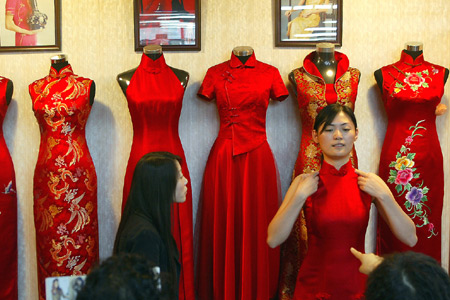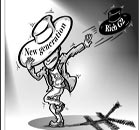Top Biz News
Traditional clothing retailers enjoy Spring Festival boom
By Yu Tianyu (China Daily)
Updated: 2010-02-27 09:11
 |
Large Medium Small |
|
 |
|
A customer tries on a traditional Chinese Qipao in a garment shop in Beijing.[China Daily] |
Retailers of delicately embroidered traditional Chinese garments such as tangzhuang jackets and qipao dresses celebrated booming sales during the Spring Festival.
Sun Xing, a garment shop owner at a wholesale market in Urumqi, Xinjiang Uygur autonomous region, said sales at his small store hit 60,000 yuan in the first two months of 2010.
He said: "Especially ahead of the festival, we received tens of orders a day as many people wished to dress up elaborately."
Sun added that tangzhuang jackets have become a fashion trend in recent years among Chinese people and foreigners, especially since 2001 when many political leaders wore silk-embroidered tangzhuang at the Asia-Pacific Economic Cooperation summit in Shanghai.
"Red and gold are two of the most popular colors. Young people prefer silk cloth with simple patterns while their elders generally choose cloth with dragon or phoenix embroidery," he said. The prices range from 400 to 1,000 yuan.
Many Chinese parents love to dress their children in tangzhuang when they take them to pay New Year visits to elders because they think it looks cute and is appropriate for the festive atmosphere, Sun said.
Shanghaixu, a Chinese brand that focuses on haute couture tangzhuang, also enjoyed good sales. It has seven outlets in Beijing, most of them in luxury hotels.
Dai Xia, store manager of a Shanghaixu outlet at the Oriental Plaza in downtown Beijing, said it received a great number of orders during the Spring Festival period.
Among bustling stores stocking many international brands, Shanghaixu outlets have a unique look. The name of the brand is written using Chinese brushes on a wooden board and all clothes stands, counters and mirrors are made of red wood carved with traditional Chinese patterns such as peonies or plum blossoms.
With the smell of Chinese traditional incense filling the air, hundreds of colorful samples of tangzhuang and qipao are displayed according to category at Dai's store.
Dai said: "As people have been having more and more business dinners, parties or annual meetings in recent years, our business has been boosted. Also, a lot of couples come to the store to select clothes for their weddings."
The prices range from 2,000 yuan to more than 10,000 yuan depending on the fabric, style and embroidery the customer chooses. They have to wait about 10 days before they receive their clothes.
Su Rui, 30, bought a pink short-sleeved qipao with silver embroidery weeks before the Spring Festival. It cost her about 5,000 yuan.
"I hosted my company's annual meeting and the qipao I wore won lots of praise," Su said. "Unlike traditional qipao, which used to be very long, this one is above the knees which makes me look sexy."
Dai said that a reason for the sales boom is that the company has made a great effort to innovate their designs, matching them to different occasions such as family dinners or formal cocktail parties.
Some of the qipao are decorated with fur and others utilize Western-style designs, for example pleated skirt hemlines.
| ||||
At the simply decorated store, most customers are elderly while occasionally some foreigners come and look around. The sales staffs' faces paint a picture of inactivity.
Fashion insiders said many traditional brands are no longer attractive to young people who have plenty of spending power as the designs are considered to be outdated and service is poor.
However, a 65-year-old Beijinger surnamed Liu said that she still prefers the time-honored brands which she has known from a very early age.













